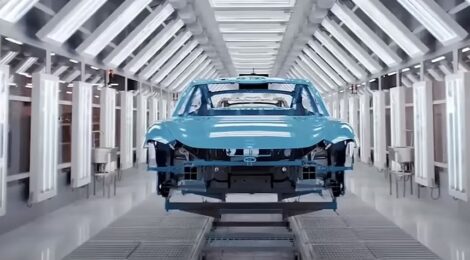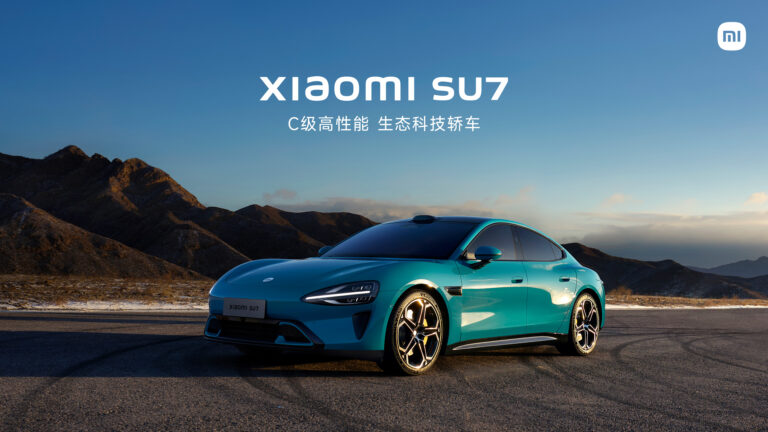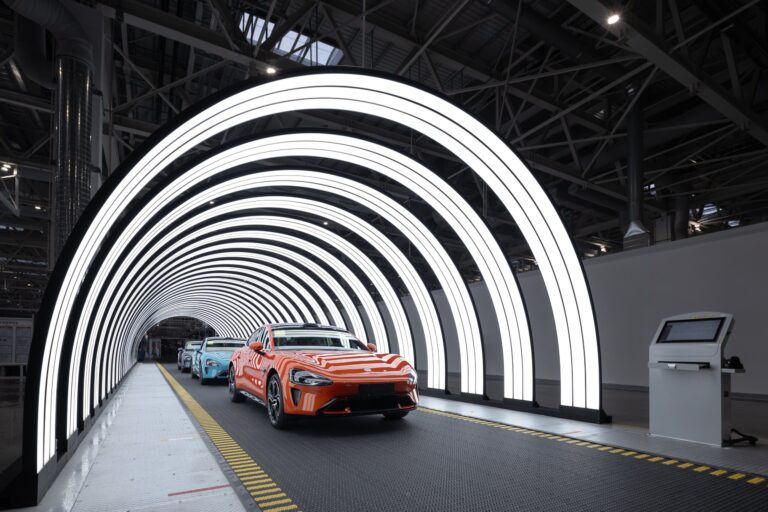
Xiaomi launches its first car, and nothing will be the same. “The long road” of the Chinese company

Xiaomi, a company still little known in the West, but omnipresent in China (every Chinese citizen, willingly or not, owns an object produced by this company) and also active in Italy, has entered the automotive business. And nothing will be the same again.
Xiaomi joins the (unbridled) race underway in China in the production of electric vehicles, and a new high-calibre player could worry Tesla and other European and Asian companies globally (an example of an “in pectore” rival is BYD). Particular interest was aroused by the publication of a video of the Xiaomi “Super Factory”, capable, according to the authors, of producing an SU7 at an impressive speed.
Has a new era of competition in the automotive sector begun with the entry into the market of this Chinese super player?

CEO Lei Jun launches the new project capable of disrupting the EV market: innovation, technologies and large numbers, with an eye on Porsche and Tesla
On the afternoon of December 28, 2023, 1,003 days after the first announcement, Xiaomi launched its first car, the SU7. Lei Jun made his first public appearance, bringing with him his Xiaomi car with “all his reputation on it”.
During the three-hour press conference, Lei Jun talked about Xiaomi’s technical progress in motors, batteries, large die casting, intelligent cockpits and intelligent driving, and said that it has achieved “global leadership” and “national leadership” in many technologies.
Since Xiaomi’s debut on the Ministry of Industry and Information Technology website, discussions about cars that resemble Porsche, Tesla, etc. they continued to rage. After the official presentation of the new car yesterday, online discussions have become more intense, with some netizens even jokingly calling Xiaomi Motors “Porsche Mi”.
Xiaomi SU7 is positioned as a C-class sedan and is divided into normal and Max versions. The length, width and height are about 5 meters, 2 meters and 1.4 meters respectively. In terms of size, it is comparable to the BMW 5 Series and is larger than the B-class Tesla Model 3. The body shape is similar to that of a sports car, equipped with teardrop headlights, halo-type rear lights and semi -Hidden light and door handles. It is available in three colors: Gulf Blue, Elegant Gray and Olive Green.
Lei Jun said that Xiaomi’s goal is to rival Porsche and Tesla and become one of the top five automakers in the world through 15-20 years of hard work.
During the press conference, Lei Jun repeatedly compared Xiaomi Auto’s core technologies with those of Porsche and Tesla. For example, Xiaomi SU7 is equipped with a 21,000-speed motor, can accelerate from 0 to 100 kilometers per hour in 2.78 seconds, has a maximum speed of 265 kilometers per hour, and has a CLTC (China Light Vehicle Driving Condition) cruising range ) of 800 kilometers. These parameters would exceed those of Porsche and Tesla.
Lei Jun said that to create an extraordinary car, Xiaomi started from a basic technology, increased its investment in research and development tenfold, and structured its layout into five main technology areas. In terms of motors, Xiaomi’s domestically developed and produced 27,200 rpm super motor will be launched in 2025. In terms of batteries, XiaoMi Motors has jointly developed an 800V high-voltage battery pack with CATL and developed the battery technology integrated CTB. The battery pack is integrated into a part of the car body, which effectively reduces the vertical height of the car and leaves more space for the passenger compartment.
Xiaomi also followed Tesla’s example and developed its own very large die casting technology, with a maximum mold closing capacity of 9,100 tons, surpassing the 6,000 tons of the Tesla factory in Shanghai and the 9,000 tons of the US factory in Tesla.
The intelligent cockpit, according to the CEO, is Xiaomi Auto’s strong point. It is equipped with the Snapdragon 8295 Cockpit chip and is based on Xiaomi’s eco-friendly Thermal OS technology. It has a 16.1-inch foldable central control ecological screen and is connected to the Xiaomi Pad ecological screen.
The issue of price, investor attention and preparation for the national climb
In the launch press conference, Lei Jun did not initially announce the price of the models, but leveraged the presence of first-rate technology which will inevitably impact the final price. According to the CEO, the car is still expensive, but for a good reason.
What the capital market looks at is the return on investment. Chinese automotive expert Wang Xianbin predicts that Xiaomi Motors will definitely suffer short-term losses in 3-5 years. It will take at least five years to turn a profit and annual sales will reach around 350,000 vehicles.
The company has wasted no time: preparations for car sales are proceeding at a rapid pace. In September 2023, Xiaomi established Xiaomi Jingming Technology Co., Ltd. in more than 10 cities including Wuhan, Shanghai and Shenzhen. Its business scope includes the sale of new energy vehicles and the sale of auto parts. For some months, Xiaomi has been incessantly recruiting staff throughout China: store managers, delivery specialists, new customer service managers and many other positions.

From virality to delivery – the road is still long
During the Tomb Sweeping Day holiday, many Xiaomi SU7 cars with temporary license plates appeared on the streets of major cities in the country. This is the first batch of founding edition models delivered to car owners by Xiaomi Motors on April 3. On social platforms, many owners of the new model started live broadcasts after the withdrawal, attracting large numbers of viewers and creating very high hype around Xiaomi Motors.
In the face of growing orders, production capacity has become a real challenge for Xiaomi Motors. According to public information, Xiaomi Auto’s Yizhuang Gigafactory has a designed annual production capacity of 150,000 vehicles. It was completed in June 2023 and is also the production center of the Xiaomi SU7. The second phase of construction has not yet officially begun. At the Xiaomi SU7 launch conference on March 28, Lei Jun revealed that the factory’s production cycle at full capacity is 76 seconds. When calculated based on this pace, the factory’s daily production on one shift is approximately 300 vehicles, and the annual production is approximately 120,000 vehicles. In the delivery plan previously announced by Xiaomi Motors, after starting delivery on April 3, the standard and Pro versions will be delivered in a large scale at the end of April, while the Max version at the end of May.
According to the initial plan, the production capacity of the first phase of Xiaomi Automobile Factory exceeded 3,000 units in March this year, rose to 4,000-5,000 units in April, and stabilized at 6,000 units by the end of the year. In other words, its delivery capacity for the whole year will be 7 approximately 10,000 vehicles.
The reaction of other Chinese players and the potential
At present, Xiaomi SU7 has entered a real battlefield. In addition to facing the price decline of independent domestic brands, with the vehicle delivery scheduled for April 3, Xiaomi SU7 will continue to face numerous important tests such as production capacity, quality and after-sales service in China, challenging other manufacturers Chinese, who did not stand by and watch.
On April 1, the third day after the launch of the Xiaomi SU7, some of them launched a new round of price cuts. According to incomplete statistics from Tech Planet, at least seven companies have launched price-cutting strategies, such as Wenjie, Xpeng and Weilai. Some automakers have stepped up replacement and subsidy efforts. Weilai, for example, has launched a subsidy of up to 1 billion yuan for the replacement of gasoline vehicles. Starting now, users of gasoline vehicles replacing new 2024 NIO vehicles will receive an additional 10,000 yuan in optional equipment fund subsidies on top of existing policies.
These price-cutting and subsidy strategies launched after the release of the SU7 are regarded by the market as an “encirclement and limitation” action of Xiaomi Motors. Chinese competitors reacted.
Goldman Sachs said in its research report released on April 1 that Xiaomi SU7 showed potential to become one of the best-selling high-end electric cars in China thanks to its industry-leading intelligent system and green advantages. However, for newcomers to the new energy vehicle market, there is undoubtedly still a long way to go.

Our point of view
Below is our point of view:
1 – Internal Chinese competition can be suffocating, but it is the engine of real change, which then reverberates internationally. Chinese car manufacturers are making impressive steps forward and they are already a reality today, at least at home.
2 – XiaoMi is not just a Chinese company, but a symbol of success, stubbornness and innovation. For those who have lived in China, there is no area of daily life that cannot be “covered” by a XiaoMi product. For this reason, the pressure that the company CEO spoke about in creating a successful product is tangible and real. XiaoMi can’t be wrong
3 – XiaoMi’s path in the production of electric cars is not obvious. We will have to follow future developments carefully. Will a XiaoMi car come to Europe and Italy one day? Too early to tell.
4 – A final “colorful” observation: the CEO of XiaoMi is a new case of “rockstar” manager, who brings with him an immense company, with Chinese, Asian and global branches, and impressive “firepower” . In this, the Americans have led the way, and the Chinese managers have followed, we can say in this case, “following suit”. It will be very interesting to follow the evolution of this manager, to understand how he will be able to manage pressure, expectations, and also what degree of freedom he will be able to have compared to a Chinese leadership that does not tolerate escapes forward. Being the CEO of a Chinese multinational company is not for many.
Written by Marco Bonaglia



